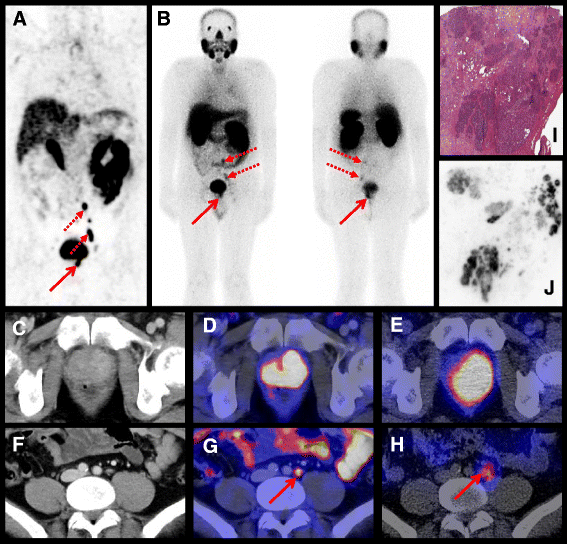[(111)In]PSMA-I&T: expanding the spectrum of PSMA-I&T applications towards SPECT and radioguided surgery
- PMID: 26608882
- PMCID: PMC4659791
- DOI: 10.1186/s13550-015-0147-6
[(111)In]PSMA-I&T: expanding the spectrum of PSMA-I&T applications towards SPECT and radioguided surgery
Abstract
Background: The relevance of prostate-specific membrane antigen (PSMA) targeting in the clinical management of prostate cancer (PCa) is continually increasing, entailing the development of PSMA-targeted molecular probes. Recently, a first PSMA-targeted theranostic concept has been successfully implemented by [(68)Ga/(177)Lu]PSMA-I&T. To further exploit the excellent PSMA-targeting characteristics and in vivo performance of the PSMA-I&T platform, [(111)In]PSMA-I&T was evaluated as a complementary probe for radioguided surgery and SPECT imaging.
Findings: Compared to [(68)Ga/(177)Lu]PSMA-I&T, [(111)In]PSMA-I&T showed unchangedly high PSMA-affinity and enhanced internalization into PSMA-expressing LNCaP PCa cells. Biodistribution studies in LNCaP xenograft-bearing mice (1 h p.i.) revealed slightly reduced background accumulation of [(111)In]PSMA-I&T compared to [(177)Lu]PSMA-I&T and identical tumor uptake of both compounds, leading to increased tumor/background ratios for [(111)In]PSMA-I&T. An exemplary patient with metastatic PCa underwent preoperative [(68)Ga]HBED-CC-PSMA PET/CT (1 h p.i.) and [(111)In]PSMA-I&T SPECT/CT (4 h p.i.), followed by prostatectomy and radioguided extended pelvic lymphadenectomy (24 h p.i.). In [(111)In]PSMA-I&T SPECT/CT, the previously identified PCa lesions ([(68)Ga]HBED-CC-PSMA PET/CT) showed high tracer accumulation and were also detectable using planar scintigraphy. The intraoperative use of a hand-held gamma probe allowed detection and resection of all [(111)In]PSMA-I&T-accumulating lesions. The presence of PSMA-positive tumor tissue in the resected specimens was confirmed histopathologically and via [(111)In]PSMA-I&T autoradiography.
Conclusions: [(111)In]PSMA-I&T shows efficient PSMA targeting in vitro and in vivo, combined with low background accumulation. In an exemplary PCa patient, [(111)In]PSMA-I&T was successfully applied for preoperative SPECT/CT visualization and radioguided resection of PSMA-positive lesions, hinting towards a high value of [(111)In]PSMA-I&T as a complementary tool to [(68)Ga/(177)Lu]PSMA-I&T in the clinical management of prostate cancer.
Keywords: 111In; 177Lu; Imaging; PET; PSMA; PSMA-I&T; Prostate-specific membrane antigen; Radioguided surgery; SPECT; Targeted radionuclide therapy.
Figures



References
-
- Kulkarni H, Baum R, Weineisen M, Wester H, Schuchardt C, Wiessalla S, et al. Therapy of metastasized castrate-resistant prostate cancer using Lu-177 labeled DOTAGA-PSMA small molecules: first clinical results in a larger patient cohort. J Nucl Med. 2015;56(supplement 3):10.
LinkOut - more resources
Full Text Sources
Other Literature Sources
Miscellaneous

